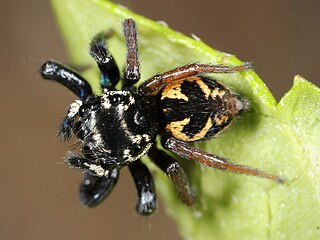
Xysticus is a genus of ground crab spiders described by C. L. Koch in 1835, belonging to the order Araneae, family Thomisidae. The genus name is derived from the Ancient Greek root xyst, meaning "scraped, scraper".

Phidippus audax, the bold jumper or bold jumping spider, is a common species of spider belonging to the genus Phidippus, a group of jumping spiders easily identified by their large eyes and their iridescent chelicerae. Like all jumping spiders, they have excellent stereoscopic vision that aids them in stalking prey and facilitates visual communication with potential mates during courting. Bold jumping spiders are native to North America and have been introduced to Hawaii, Nicobar Islands, Azores, and the Netherlands. They are typically black with a distinct white triangle on their abdomen.

Beata is a genus of jumping spiders that was first described by George Peckham & Elizabeth Peckham in 1895.

Chira is a genus of jumping spiders that was first described by George Peckham & Elizabeth Peckham in 1896. It is currently named after Rio Chira, a river in Peru, but the Peckhams originally called the genus Shira, later emended by Eugène Simon.

Corythalia is a genus of jumping spiders that was first described by Carl Ludwig Koch in 1850. The genus is distributed throughout most of the Western Hemisphere.

Lyssomanes is a spider genus of the family Salticidae, ranging from South and Central America, up to the southern United States.

Marpissa is a genus of jumping spiders that was first described by Carl Ludwig Koch in 1846. The name is derived from Marpissa, an ancient Greek village.

Sassacus is a genus of jumping spiders that was first described by George and Elizabeth Peckham in 1895. It is likely named after Sassacus, a Native American chief of the 16th and 17th century.

Synemosyna is a genus of ant mimicking jumping spiders that was first described by Nicholas Marcellus Hentz in 1846.

Uloborus is a spider genus in the family Uloboridae with 80 described species. Most species occur in the tropics and subtropics, with only few species in northern America and Europe.

Castianeira is a genus of ant-like corinnid sac spiders first described by Eugen von Keyserling in 1879. They are found in Eurasia, Africa, and the Americas, but are absent from Australia. Twenty-six species are native to North America, and at least twice as many are native to Mexico and Central America.

Lycosa is a genus of wolf spiders distributed throughout most of the world. Sometimes called the "true tarantula", though not closely related to the spiders most commonly called tarantulas today, Lycosa spp. can be distinguished from common wolf spiders by their relatively large size. This genus includes the European Lycosa tarantula, which was once associated with tarantism, a dubious affliction whose symptoms included shaking, cold sweats, and a high fever, asserted to be curable only by the traditional tarantella dance. No scientific substantiation of that myth is known; the venom of Lycosa spiders is generally not harmful.

Tibellus is a genus of slender crab spiders described by Simon in 1875, belonging to the order Araneae, family Philodromidae. Species of this genus are present in Eurasia, Africa, Americas and Australia.

Olios is the largest genus of huntsman spiders, containing 166 species. They are found throughout the world, with most species occurring in hot countries. The genus was first described by Charles Athanase Walckenaer in 1837.

Oxyopes is a genus of lynx spiders found worldwide. It includes arounds 300 species and is classified under the lynx spider family Oxyopidae. Like other lynx spiders, they are easily recognizable by the six larger eyes arranged hexagonally on top of the head (prosoma), with the remaining smaller two eyes in front. They are also characterized by long spine-like bristles (setae) on their legs. They are ambush predators, actively hunting prey by sight. Though they produce and use silk, they do not build webs to capture prey.

Colonus is a genus of spiders in the jumping spider family, Salticidae. Colonus species are endemic to North and South America, ranging from New York to Argentina. All members of the genus have two pairs of bulbous spines on the ventral side of the first tibiae. The function of these spines is unknown. Colonus was declared a junior synonym of Thiodina by Eugène Simon in 1903, but this was reversed by Bustamante, Maddison, and Ruiz in 2015.

Synema is a genus of spider in the family Thomisidae, found in most parts of the world.

















